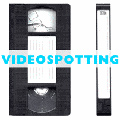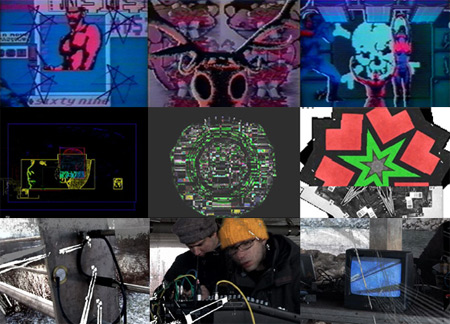|
DIVA Station & Videospotting
 Feedback Loop 2 at Feedback Loop 2 at
Museum Summer Night 2016
 Video screening Video screening
Saturday, 18 June 2016, from 10pm
Facade +MSUM, Maistrova 3, Ljubljana
We are joining the traditional Museum Summer Night with a two-hour screening program entitled Feedback Loop 2 at a Museum Square in Ljubljana.
The video program Feedback Loop 2 curated by Ida Hiršenfelder presents the part of video archive which is extremely important for understanding video art and its social impact, but remains almost entirely unnoticed and non-representational.
Feedback Loop (in its first version) was premiered on media facade of Museum of Contemporary Art Zagreb in 2014. The second edition of the program is showcasing a new selection.

Feedback Loop 2
Concept: Ida Hiršenfelder
In selected video works the artists are dealing with experimental use of video language which does not fit into the time limit prescribed by conventional presentation formats at galleries and festivals. Neither do these works fit into the logic of a narrative story line. These are visual experiments that include the aesthetics of boredom with constant repetition and slight modulation of visual effects. Initially, a lot of them were not meant to ever be shown at a gallery space to start with. Numerous long format video artworks with constant feedback loops were recorded by artists as a by-product of their VJ performances (Maja Smrekar); or as a collage of recordings that had been treated as invaluable material ever since the 80s and had been constantly re-cut, re-mixed, re-used (Rok Sieberer – Kuri); or as experiments with early video oscillators (such as early experiments by Miha Vipotnik from the 70s); or, last but not least, as experiments produced by generative computer programs for AV manipulation and transfer of data via streaming (Tanja Vujinović, Luka Dekleva, and Luka Prinčič).
The initial production environment of the selected works was not art institution, therefore it seems only fair to the works to present them outside the strict gallery or museum setting, where the projection as well as the conditions of viewing are naturally changed. The public outdoor space does not demand a fixed attention, but rather attracts a numerous casual passers-byes.
Video works:
Maja Smrekar, Imaginarium of Electromagnetic Transformations, 28′9″, 2009
Experimental video and sound work with multi-layered structure is made with various technological means from the perspective of investigative and formal video and sound approaches that the artist finds in the crossroad of analogue and digital manipulations of images.
Neven Korda/Borghesia, Poppers, 4′5″, 1989
The images are synchronized with music (in frame of Borghesia multi-media group). We are faced with a flood of symbols that are indiscriminately mixing the images of pop heroes from comics with topless gay men with muscular figure and a cigarette in his mouth, and instant moments with flashing women figure on display. The images are overlapping, cutting, sneaking over the screen in a fast tempo with spilled saturated colours.
Luka Dekleva: Sen/za Televizijo/a, 28′38″, 2009
The video is a result of artistic collaboration with Miha Vipotnik during the Sen/za Televizijo/a project at Jakopič Gallery, marking 30 years to the date after the first transmission of Vipotnik’s television video project Videogram 4 on May 4th, 1979. Dekleva’s work is an element of re-make of Videogram 4.
Rok Sieberer – Kuri, Technotime, 30′11″, 1999
Video is playing with abstract forms of coloured masses dancing on the screen and changing shapes. The artist uses found footages from television news reports that he digitally manipulated, he typically uses fast changes of scenes and fast rhythm of video editing.
Tanja Vujinović, Extagram / Oscilo 15′26″, 2007
Stuffed plush objects, electronics (speakers, video camera, contact microphones, computer, audio mix) are a part of series of projects entitled Discreet Events in Noisy Domains. The installation is a tactile-sonic objects or environments. Multiple nonlinear video and audio systems are (re)encoding events into data streams of audio-visual noise.
Miha Vipotnik, Video graphics, 17′20″, 1975
The video is an early attempt of computer animation through an interaction of camera and monitor. The graphic symbol is in constant motion. Effects vary with the intervention of a hand in front of the monitor. Notwithstanding the fact that Vipotnik’s early works were created under the influence of classic painting, the Video graphics are interesting, since they consider painting in the spirit of the current time and – more importantly – provide an experimental dimension of painting that classic painting was not able to convey.
Luka Dekleva in Luka Prinčič, Singing Bridges Bizovik, 4′07″, 2008
Singing Bringes Bizovik is a video performance in which the sound is coming from the microphones mounted on cables and construction of the bridge.
Production: SCCA-Ljubljana, 2016
In cooperation with: Museum of Modern Art Ljubljana +MSUM
Support: Municipality of Ljubljana – Department for Culture
Thanks: Tomaž Kučer and Adela Železnik (MG +MSUM)
[Published: June 15, 2016]
|

